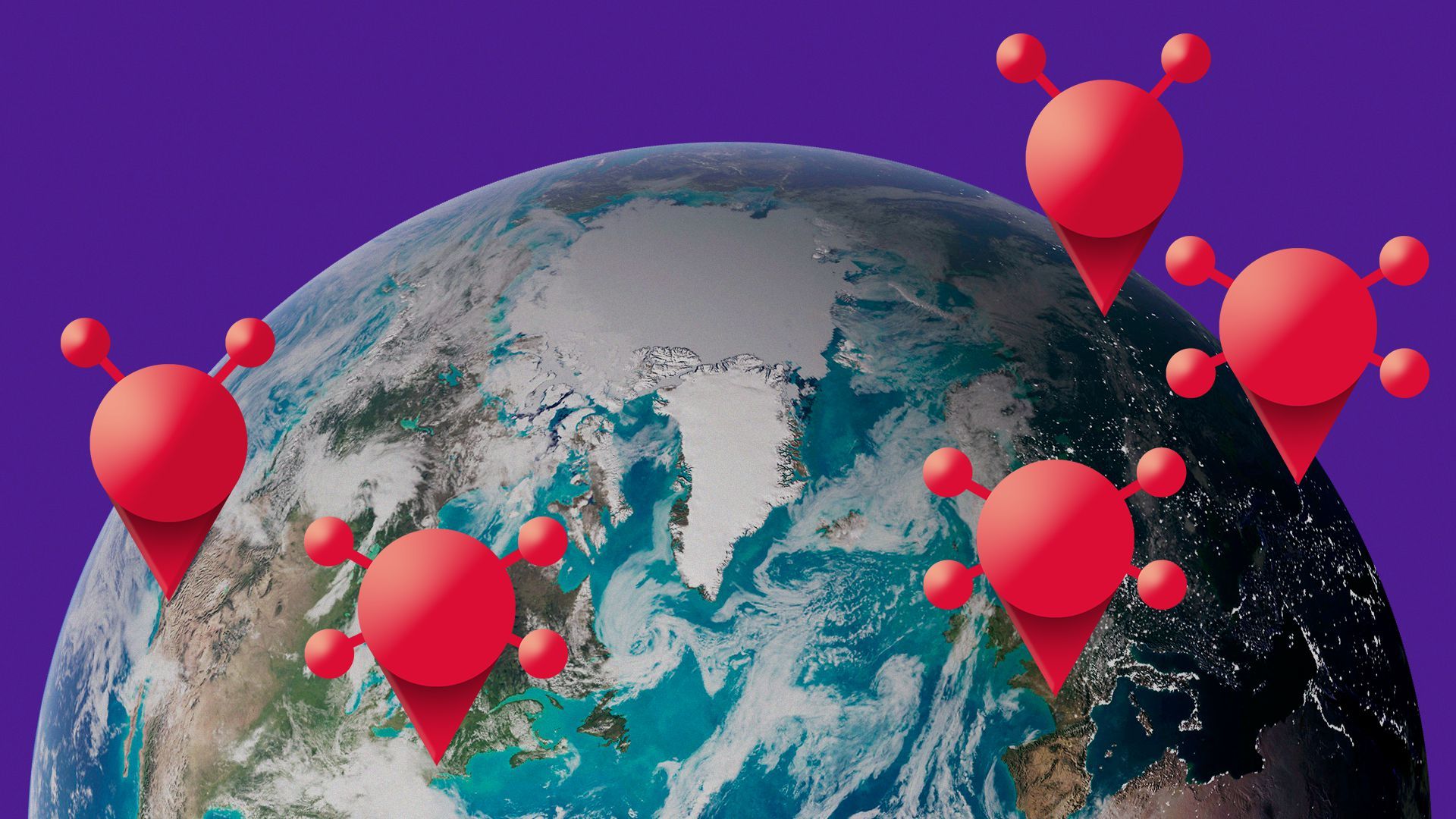| | | | | | | Presented By Foundation Medicine | | | | Axios Science | | By Alison Snyder · Nov 10, 2022 | | Thanks for reading Axios Science. This week's newsletter is 1,521 words, about a 6-minute read. | | | | | | 1 big thing: Tracking methane from space |  | | | Illustration: Rae Cook/Axios | | | | Satellites orbiting Earth are providing data to precisely point scientists, companies and governments to sources of methane — a strong greenhouse gas. Why it matters: Cutting methane emissions could help to slow global warming in the next few decades. But efforts to reduce methane hinge on knowing where and how much of the gas is being emitted — and whether companies and governments are responding. Driving the news: Cutting methane emissions is high on the agenda at this week's UN COP27 climate summit in Sharm el-Sheikh, Egypt. - The U.S. and EU are expected to announce an agreement to reduce methane emissions from the fossil fuel sector, Reuters reports. Policies to stop the flaring of gas and to require companies to fix leaks are included in the draft of the pledge.
- The Climate TRACE coalition released emissions estimates based on satellite imagery and direct gas measurements and found methane leaks and flares during oil and gas production are underreported.
- The findings haven't been peer-reviewed but suggest methane emissions are much higher — as much as three times — than what countries and companies are reporting.
How it works: Methane makes up about 16% of greenhouse gas emissions but these simple molecules of a single carbon atom bonded to four hydrogen atoms are a fast-acting global-warming gas. - Methane traps 80 times more heat in the atmosphere than carbon dioxide.
- It also lasts a few decades in the atmosphere compared to hundreds of years for carbon dioxide. That's why climate advocates want to focus on reducing emissions of methane now to try to buy time as they attempt to figure out how to remove carbon dioxide from the atmosphere.
Where it stands: More than 100 countries pledged last year to voluntarily reduce emissions of methane by at least 30% of 2020 levels by the year 2030. - But emissions are still increasing, according to a report released earlier this year by the methane monitoring company, Kayrros.
Zoom in: Major sources of methane from human activities include oil and gas production, agriculture and waste management. About 18% of global methane emissions come from decaying solid waste in landfills, with China, India and the U.S. as the top emitters in the waste sector. - In a recent paper published in Science, researchers used data from the TROPOMI instrument on an ESA satellite and from emissions monitoring company GHGSat to spot methane-emitting sites.
- They detected and analyzed super-emitting landfills — which released 3 to 29 tons of the gas per hour — in Buenos Aires, Delhi, Lahore, and Mumbai.
- The team followed up by releasing a global map of more than 100 methane super-emitting landfills — found on every continent but Antarctica — this week at the climate summit.
The big picture: Methane emissions are being detected and tracked by space agencies and companies using a range of instruments on satellites orbiting Earth, as well as low-flying aircraft and thermal imaging. Satellite instruments operate at different frequencies and resolutions, and offer a range of data streams. - NASA's Earth Surface Mineral Dust Source Investigation (EMIT) mission onboard the International Space Station (ISS) is now mapping methane-emitting hotspots.
- About 1,200 parallel imaging spectrometers on EMIT collect 300,000 light absorption patterns of minerals as well as gases in the atmosphere, including methane — per second.
- The instrument, which measures visible and infrared light and has a resolution down to 60 meters, is "the first of its class," says Robert O'Green, principal investigator of EMIT at NASA's Jet Propulsion Laboratory.
Read the entire story. |     | | | | | | 2. Meteor showers rain clues about the solar system |  | | | Illustration: Annelise Capossela/Axios | | | | Hundreds of years after meteor showers were first observed, these cosmic spectacles are still delivering scientific clues to researchers on Earth, Axios' Miriam Kramer writes. Why it matters: Meteors bring information about their parent asteroids and comets, which carry evidence of the solar system's history and help scientists to study the origins of Earth and other planets. - Understanding meteor showers also allows space agencies and companies to keep their spacecraft in orbit safe by knowing more about the environment that surrounds them.
- Rocks and dust can impact satellites at high speed, potentially damaging them or taking them out of service.
What's happening: November and December are banner months for annual meteor showers, and scientists around the world will be keeping an eye on these shooting stars. - The Taurid meteor shower is ongoing, and the Leonid meteor shower is expected to peak mid-month.
Each meteor shower has different characteristics. - "Taurids produce a lot of fireballs, not because they're fast but because they're more pebble- and baseball-sized. Whereas, the Leonids are fast, extremely fast, but they're specks of dust," NASA astronomer Bill Cooke tells Axios.
- Fireballs are defined as meteors that appear about as bright or brighter than Venus in the night sky.
- The Geminid meteor shower — often one of the best of the year — will peak in mid-December, bringing bright fireballs to dark skies.
How it works: Researchers use powerful radar systems around the world to survey the sky for meteors. - Some of those radar systems run 24/7, but other, more specialized and powerful instruments that can pick up on extremely small meteors, only operate for a short amount of time because of the cost to run them.
- Citizen scientists with their own backyard cameras also contribute important data to the field, Quanzhi Ye, an astronomer at the University of Maryland College Park, tells Axios. Those contributions can include information about the frequency and timing of meteors.
Read the entire story. |     | | | | | | 3. Worthy of your time | | Are trees talking underground? For scientists, it's in dispute (Gabriel Popkin — NYT) CRISPR cancer trial success paves the way for personalized treatments (Heidi Ledford — Nature) An unprecedented exodus of young life scientists is shaking up academia (Jonathan Wosen — STAT) |     | | | | | | A message from Foundation Medicine | | Prostate, lung and colorectal cancers make up about 43% of cases in men | | |  | | | | During Men's Health Awareness Month, we recognize each unique patient. Foundation Medicine tests accelerate treatment development and streamline research efforts around the globe. Learn more about our commitment to providing the insights needed to take action for patients. | | | | | | 4. Total lunar eclipse |  | | | The Moon is seen Tuesday during a total lunar eclipse in Tokyo, Japan. Photo: Wei Ran/Xinhua via Getty Images | | | | If you missed this week's total lunar eclipse, you won't get to see another one for more than two years, Axios' Kelly Tyko writes. - The next total lunar eclipse won't occur until March 14, 2025, though partial and penumbral lunar eclipses will continue to take place before then, according to NASA.
The big picture: Lunar eclipses are sometimes called "Blood Moons" because the Moon will turn a reddish hue. - This happens when the Moon is in the darkest part of Earth's shadow, which is called the umbra, NASA said.
- The Moon turns red because the only sunlight reaching it "passes through Earth's atmosphere. The more dust or clouds in Earth's atmosphere during the eclipse, the redder the Moon will appear. It's as if all the world's sunrises and sunsets are projected onto the Moon."
|     | | | | | | 5. Something wondrous |  | | | Ponding from a beaver dam in Colorado's East River, September 2018. Photo: Christian Dewey | | | | Built stick by stick, beaver dams can improve the quality of river water, potentially mitigating one of the consequences of climate change, scientists reported this week. Why it matters: In the future, scientists expect water quality will become worse as drought tends to concentrate contaminants like nitrate in water. - But the researchers found "despite the degradation expected to occur, the simultaneous restoration of beaver populations will help mitigate that degradation," says Christian Dewey, a soil biogeochemist at the University of Oregon and co-author of the new study.
The big picture: Beaver populations were decimated in the American West 100 years ago. - But they rebounded due to a combination of policies to protect the animals and changes in land management while a warming climate is allowing the animals to move into new ranges.
- Researchers knew beaver dams could affect water quality by diverting water into soil. The new study compared the effects of the dams on the hydrology and biochemistry of the riparian zones where the land and river meet under different climate extremes.
How they did it: Dewey, who carried out the research as a graduate student at Stanford University, was studying the impact of snowmelt and severe rains on the course of Colorado's East River in 2017 when a beaver built a dam in the middle of his study site. - He took samples in the river in 2018, when there was a historic drought in the area.
- By 2019, the dam had washed away and the river's water levels were relatively high. Together the years of data captured future climate extremes, Dewey says.
- He and his collaborators found the beaver dams improved water quality when there are extremely high or low water conditions, they reported this week in the journal Nature Communications.
How it works: Beaver dams cause water to back up and be pushed into the surrounding soil. Nitrate and other compounds in the water are moved as well, fueling microbes in the soil that convert nitrate into nitrogen gas. - The dams are moving more nitrate into the soil, allowing more to be removed compared to other conditions.
- And, with potentially more dams built as beavers expand their range, there is more cleaning potential, Dewey says.
What's next: The impacts of beaver dams should be investigated in flat areas, like the Great Plains, he says. - Future research could also look at concentrations of methane in the pooled water — perhaps by using remote sensing from satellites and combining it with molecular analysis.
"The feedback we are observing is a rare bright spot in climate news," Dewey says, adding it is a "hopeful" finding that suggests "nature is pushing back." |     | | | | | | A message from Foundation Medicine | | Cancer survivorship is on the rise | | |  | | | | The number of cancer survivors in the U.S. is projected to increase to 22.2M by 2030, according to NIH. The strategy: Foundation Medicine is transforming care by using genomic sequencing to help oncologists connect patients with targeted treatments for their specific cancer type. Learn more. | | | | Big thanks to Laurin-Whitney Gottbrath for editing this newsletter and to Carolyn DiPaolo for copy editing this edition. |  | | Are you a fan of this email format? It's called Smart Brevity®. Over 300 orgs use it — in a tool called Axios HQ — to drive productivity with clearer workplace communications. | | | | | | Axios thanks our partners for supporting our newsletters. If you're interested in advertising, learn more here.
Sponsorship has no influence on editorial content. Axios, 3100 Clarendon Blvd, Arlington VA 22201 | | | You received this email because you signed up for newsletters from Axios.
Change your preferences or unsubscribe here. | | | Was this email forwarded to you?
Sign up now to get Axios in your inbox. | | | | Follow Axios on social media:    | | | | | |
No comments:
Post a Comment